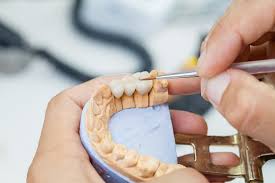A dental bridge is a fixed appliance that replaces one or more missing teeth by joining an artificial tooth to the teeth beside the gap. If you are missing a permanent tooth, a bridge offers a way to fill the space in your smile. This device is custom-made by your dentist. Here is more information about determining if a dental bridge is a solution for you:
Losing a Permanent Tooth
You may lose a tooth due to injury or decay. When a permanent tooth is lost, the surrounding teeth start to shift. Over time, this movement may affect your bite alignment, and it is important to monitor any changes.
A shift in your bite brings new challenges with chewing and speaking, and your dentist will look at nearby teeth. The teeth beside the gap must be healthy to support a bridge. These abutment teeth are shaped in a manner that allows the bridge to attach firmly with crowns for anchoring.
Your hygiene habits also play a significant role. Brushing and flossing daily are helpful to maintain both the bridge and adjacent teeth in good condition. Plaque and food particles can get trapped under the bridge, and this may lead to gum problems if not removed.
Having a Gap
The location and size of the gap in your mouth help determine your options, since a bridge needs support from healthy teeth on either side. This solution may work well for replacing one or two consecutive missing teeth. Your dentist can examine the gap and discuss with you what options fit your mouth. When reviewing possible solutions, your dentist might reference:
- Dental implants
- Partial dentures
- Dental bridges
A larger gap with several missing teeth is less likely to be addressed with a bridge because it might not stay stable. If the span is too great, it adds pressure on the anchor teeth. A dental professional will examine your specific case and guide you to the most suitable choice.
Providing an Implant Alternative
A dental bridge serves as a non-surgical option. Getting a dental implant means surgically placing a metal post into your jawbone, which isn’t the preferred option for everyone. A bridge is less invasive than an implant procedure. It may also be a faster process compared to implants, requiring fewer appointments to complete. Additionally, dental bridges can be an affordable solution for restoring both the functionality and aesthetics of your smile.
Avoiding Bone Loss
Tooth roots stimulate the jawbone and maintain bone density. If a tooth is lost, the bone in that spot may begin to deteriorate gradually. While a bridge does not halt bone loss under the open space, it keeps your remaining teeth in their positions and supports your ability to chew. It may help prevent bone loss in the following ways:
- Prevents neighboring teeth from shifting into the gap, which can affect the jawbone structure.
- Preserves proper bite alignment, reducing undue stress on the jawbone.
- Maintains support for facial structure by minimizing the risk of further dental complications.
Get a Dental Bridge Today
You may want to schedule a visit with your dentist to explore dental bridge options. Your provider will perform a thorough evaluation and explain the process if a bridge fits your needs. Take a step by making an appointment with a dentist to discuss the next steps.









